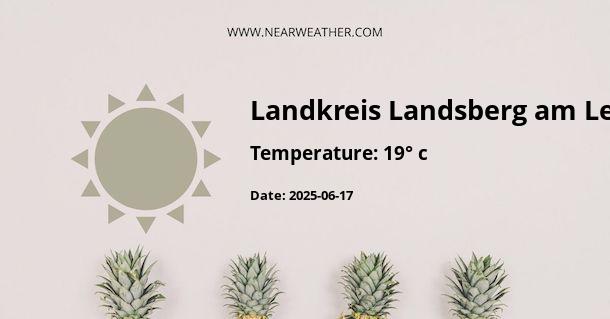Climate Overview of Landkreis Landsberg am Lech, Germany
Landkreis Landsberg am Lech is a district in Bavaria, Germany, situated to the west of Munich. Characterized by its picturesque towns, historical landmarks, and a natural landscape that ranges from river valleys to rolling hills, understanding its climate is essential for both residents and visitors seeking to explore this unique region. The climate in Landkreis Landsberg am Lech is predominantly continental, with cold winters, warm summers, and moderate seasonal precipitation.
Seasonal Climate Variations
Throughout the year, Landkreis Landsberg am Lech experiences a full range of seasons, each with distinct weather patterns:
- Spring: From March to May, the weather gradually warms, with average temperatures ranging from 5°C to 15°C (41°F to 59°F). This period marks a transition from the cold winter, yet could still witness occasional frost.
- Summer: June through August sees the warmest weather, with average temperatures sitting between 17°C and 25°C (63°F to 77°F). Heatwaves are possible during these months, sometimes leading to temperatures exceeding 30°C (86°F).
- Autumn: September to November signals a cooling phase with temperatures from 10°C to 19°C (50°F to 66°F). The foliage transforms into vivid colors, but the weather can be unpredictable with increased rainfall.
- Winter: December through February are the coldest months, with averages between -2°C and 4°C (28°F to 39°F). Snow is common, particularly in January and February, and can affect transportation.
Precipitation and Weather Events
Landkreis Landsberg am Lech experiences a moderate level of precipitation year-round. The average annual rainfall is about 980 mm (38.6 inches), with July generally being the wettest month and January the driest. The district is also subject to occasional weather extremes, such as:
- Thunderstorms and Heavy Rains: Especially in the summer months, thunderstorms can occur, sometimes leading to heavy rains and even local flooding.
- Snowstorms: Winter months can bring snowstorms, which can create picturesque scenes but also potential disruptions.
- Frost: Late spring and early autumn can experience frost nights, which may impact agricultural activities in the region.
Monthly Climate Statistics
For a more detailed understanding, here are the average monthly temperature and precipitation statistics:
| Month | Average High (°C) | Average Low (°C) | Precipitation (mm) |
|---|---|---|---|
| January | 2 | -4 | 40 |
| February | 3 | -3 | 40 |
| March | 8 | 0 | 50 |
| April | 13 | 3 | 60 |
| May | 18 | 7 | 90 |
| June | 21 | 10 | 120 |
| July | 24 | 12 | 130 |
| August | 23 | 12 | 120 |
| September | 19 | 9 | 90 |
| October | 13 | 5 | 60 |
| November | 7 | 1 | 60 |
| December | 3 | -3 | 50 |
Note that recent changes in global climate patterns might lead to deviations from these historical averages, and the extremes are expected to become more frequent and severe due to climate change.
Wind and Sunlight Conditions
In terms of wind, Landkreis Landsberg am Lech experiences moderate breezes coming predominantly from the west. The shelter provided by the surrounding topography can lead to calm days with little wind, especially during the autumn and winter months. In terms of daylight, the region enjoys longer daylight hours during the summer with shorter days in the winter, a typical pattern for continental Europe.
Geographical Influence on Climate
The terrain of Landkreis Landsberg am Lech ranges from the Alpine foothills to flatter plains towards the north. This topographical variation influences microclimates throughout the district. Areas located at higher elevations tend to experience cooler temperatures and more precipitation when compared to lower-lying regions. Proximity to lakes, such as the Ammersee, can also result in local variations in humidity and fog, particularly in the mornings.
"Understanding local climate conditions is crucial for optimizing agricultural practices, planning outdoor activities, and preparing for weather-related challenges. The distinct seasonal change in Landkreis Landsberg am Lech provides a dynamic environment that residents and visitors can enjoy, provided they stay informed and prepared for its variabilities." – Local Meteorological Expert.
Adaptation and Preparation
Residents and businesses in Landkreis Landsberg am Lech adapt to the climate by employing various measures. They incorporate weather-resilient infrastructure, such as appropriate insulation for buildings to combat the cold winters and heat waves and employ advanced drainage systems to manage heavy rainfalls. Additionally, agricultural practices are adapted to the local climate to ensure efficient water use and crop resilience.
Climate Trends and Research
Researchers and climate analysts continuously study the region's climate by analyzing historical data and climate models. These insights are crucial to anticipate future climate conditions which may affect the region due to global climate change. It is particularly important for long-term planning in critical sectors like agriculture, infrastructure development, and natural resource management.
In conclusion, the climate of Landkreis Landsberg am Lech is characterized by continental influences with distinct seasons, moderate precipitation, and temperature variability influenced by geographical elements. Being knowledgeable about these patterns and factoring in potential changes due to climate trends is key for effective planning and adaptation strategies.
A - Landkreis Landsberg am Lech's Latitude is 48.038891 & Longitude is 10.971390.
A - Weather in Landkreis Landsberg am Lech is 5° today.
A - Climate Conditions in Landkreis Landsberg am Lech shows overcast clouds today.
A - Humidity in Landkreis Landsberg am Lech is 86% today.
A - Wind speed in Landkreis Landsberg am Lech is 33.34 km/h, flowing at 210° wind direction. today.
